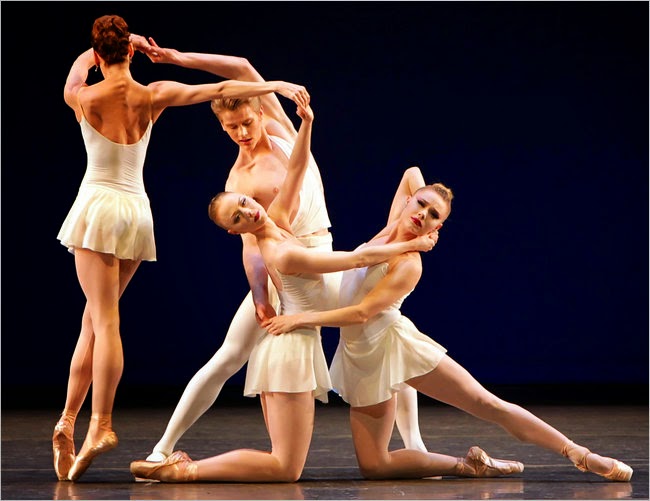Balanchine Black and White
New York City Ballet
May 7, 2011, matinee performance
Apollo, Square Dance, Agon
This afternoon at the NYCB I saw an extraordinary interpretation of Apollo by a newcomer, who is still listed only as a corps de ballet member. Chase Finlay danced like a god, and at the end of the performance the usually somnolent NYCB audience gave him a roar of approval. Hard to believe this is only his second performance of the ballet. I knew when the curtain rose and Finlay began to swing his arms with a slow but thrilling acceleration that this was not "just another" Apollo. Throughout the whole ballet he showed extraordinary confidence and musicality of a kind that cannot be taught. He also partnered the three muses with sensitivity and skill. Even though Balanchine made Apollo less and less of a narrative ballet over the years with different revisions, Finlay brought a sense of story to the ballet -- that of a young god's coming of age. He was with the muses alternately playful and shy, and that moment when Terpsichore cups his face in her hands was startlingly tender. I miss the old ending, in which Apollo was led up the stairs to Mount Olympus (it can be seen in the dvd about Jacques d'Amboise), but the later "sun-dial" ending did make for a striking final tableau. Finlay had help with his three muses -- Ana Sophia Scheller (Calliope), Tiler Peck (Polyhymnia), and Sterling Hyltin (Terpsichore). All three ladies captured the playful, flirtatious spirit behind their variations, and Hyltin and Finlay in their famous pas de deux looked as if they were born to dance together. If I have one slight quibble with Hyltin is that she made Terpsichore almost too sweet. In my opinion the Muses should be flirtatious, but also a bit aloof, as all muses are. It was all in all a magnificent performance. By the way before the performance started I saw Peter Martins stride to his seat in the back of the orchestra. He looked older but still handsome, and I wonder how he must have felt seeing his trademark role danced with such aplomb by Finlay.
It was overall an excellent performance. Andrew Veyette was elegant and princely in the Sarabande, Teresa Reichlen both queenly and seductive in the Bransle Gay. I love the sweep of her grande battements, and her Farrell-like use of her wide hips and long legs. She had two excellent partners in Amar Ramanasar and Daniel Applebaum. I love the moment when she dives down further in arabesque penchee, to grab the hands of her two men. In the climactic pas de deux, I thought Sebastien Marcovici seemed a little unsure of himself in some moments of the tricky, spidery partnering. When he lay down on the floor I saw his hand shake as he reached for Wendy Whelan's hand. Whelan herself is going through a real Indian summer in her dancing -- she's now blonder, gained more weight, and as a result her famously hard, angular plumb line has softened and become more feminine. Part III of this ballet is always so thrilling, down to the final image of the four men with their backs to the audience, images frozen while still in motion. A sexy, provocative ending to Balanchine's sexy, provocative masterpiece.
The best Balanchine ballets I feel create their own universe in which time seems to stand still, and one has the feeling that after the curtain falls, Apollo and Terpsichore will continue to dance. The timelessness of Balanchine's ballets was brought to the forefront after the performance, when the NYCB presented a seminar on Apollo. Peter Martins, one of NYCB's most famous Apollos, was of course on hand to give his thoughts on the ballet, and the Apollo and Terpsichore of today's performance, Chase Finlay and Sterling Hyltin, danced parts of the ballet, with Martins occasionally offering corrections. I realized I wasn't tired of seeing Apollo less than two hours after just seeing the whole ballet. The narrator of the seminar, Nancy Goldner, got into an interesting exchange with Martins about Balanchine's deletion of the birth scene and the coda. Martins defended the choice, saying that Balanchine said, "Who wants to see a woman give birth onstage?" Goldner retorted, "I still want to see the whole ballet." Martins shot back, not a little testily, "Well go to another country then. They like to do it, we don't." A nice reminder that Balanchine ballets are not museum pieces, and that debates about which versions to perform, and how to present them, are still very vital and even controversial.




They like to do it, we don't."
ReplyDeleteHah! Is that the royal "we" he's using, or does the entire artistic staff agree? I'll bet the dancers would relish the chance to do the whole ballet.
Well the way Peter Martins was talking, he certainly didn't leave room for argument, lol. Anyone else get a little creeped out by him calling Sterling Hyltin "sweetheart"? It sounded a little condescending.
ReplyDeleteHe calls everyone that, including the students he teaches at the School of American Ballet.
ReplyDeleteP.S. You can see if you watch the web series "Strictly Ballet".
ReplyDelete